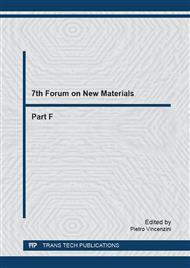[1]
M.J. Farquharson, A. Al-Ebraheem, G. Falkenberg, R. Leek, A.L. Harris, D.A. Bradley, The distribution of trace elements Ca, Fe, Cu and Zn and the determination of copper oxidation state in breast tumour tissue using μSRXRF and μXANES, Phys. Med. Biol. 53 (2008).
DOI: 10.1088/0031-9155/53/11/018
Google Scholar
[2]
A.F. Chambers, L.M. Matrisian, Changing view of the role of matrix metalloprotinases in metastasis, J. Natl. Cancer. Inst. 89 (1997) 1260-1270.
Google Scholar
[3]
B.A. Webb, M. Chimenti, M.P. Jacobson, D.L. Barber, Dysregulated pH: a perfect storm for cancer progression, Nat. Rev. Cancer 11 (2011) 671-677.
DOI: 10.1038/nrc3110
Google Scholar
[4]
M.E. Stearns, M. Wang, Type IV collagenase (M(r) 72, 000) expression in human prostate: benign and malignant tissue, Cancer. Res. 53 (1993) 878-883.
Google Scholar
[5]
B. Davies, J. Waxman, H. Wasan, P. Abel, G. Williams, T. Krausz, D. Neal, D. Thomas, A. Hanby, F. Balkwill, Levels of matrix metalloproteases in bladder cancer correlate with tumor grade and invasion, Cancer. Res. 53 (1993) 5365-5369.
Google Scholar
[6]
M.A. Moses, D. Wiederschain, K.R. Loughlin, D. Zurakowski, C.C. Lamb, M.R. Freeman, Increased incidence of matrix metalloproteinases in urine of cancer patients, Cancer. Res. 58 (1998) 1395-1399.
Google Scholar
[7]
M. Egeblad, Z. Werb, New functions for the matrix metalloproteinases in cancer progression, Nat. Rev. Cancer 2 (2002) 161-174.
DOI: 10.1038/nrc745
Google Scholar
[8]
R.A. Gatenby, E.T. Gawlinski, A.F. Gmitro, B. Kaylor, R.J. Gillies, Acid-mediated tumor invasion: a multidisciplinary study, Cancer. Res. 66 (2006) 5216-5223.
DOI: 10.1158/0008-5472.can-05-4193
Google Scholar
[9]
C. Stock, A. Schwab, Protons make tumor cells move like clockwork, Pflugers Arch. 458 (2009) 981-992.
DOI: 10.1007/s00424-009-0677-8
Google Scholar
[10]
R. Weissleder, V. Ntziachristos, Shedding light onto live molecular targets, Nat. Med. 9 (2003) 123-128.
DOI: 10.1038/nm0103-123
Google Scholar
[11]
R. Weissleder, C.H. Tung, U. Mahmood, A. Bogdanov, In vivo imaging of tumors with protease-activated near-infrared fluorescent probes, Nat. Biotechnol. 17 (1999) 375-378.
DOI: 10.1038/7933
Google Scholar
[12]
C. Bremer, C.H. Tung, R. Weissleder, In vivo molecular target assessment of matrix metalloproteinase inhibition, Nat. Med. 7 (2001) 743-748.
DOI: 10.1038/89126
Google Scholar
[13]
J. O. McIntyre, B. Fingleton, K.S. Wells, D.W. Piston, C.C. Lynch, S. Gantam, L.M. Matrisian, Development of a novel fluorogenic proteolytic beacon for in vivo detection and imaging of tumour-associated matrix metalloproteinase-7 activity, Biochem. J. 377 (2004).
DOI: 10.1042/bj20030582
Google Scholar
[14]
Y. Zhang, M.K. So, J.H. Rao, Protease-modulated cellular uptake of quantum dots, Nano Lett. 6 (2006) 1988-(1992).
DOI: 10.1021/nl0611586
Google Scholar
[15]
S. Lee, E.J. Cha, K. Park, S.Y. Lee, J.K. Hong, I.C. Sun, S.Y. Kim, K. Choi, I.C. Kwon, K. Kim, C.H. Ahn, A Near-infrared-fluorescence-quenched gold-nanoparticle imaging probe for in vivo drug screening and protease activity determination, Angew. Chem. Int. Ed. 47 (2008).
DOI: 10.1002/anie.200705240
Google Scholar
[16]
S. Nigam, K.C. Barick, D. Bahadur, Development of citrate-stabilized Fe3O4 nanoparticles: conjugation and release of doxorubicin for therapeutic applications, J. Magn. Magn. Mater. 323 (2011) 237-243.
DOI: 10.1016/j.jmmm.2010.09.009
Google Scholar
[17]
C. J. Yu, S. M. Wu, W. L. Tseng, Magnetite nanoparticle-induced fluorescence quenching of adenosine triphosphate-BODIPY conjugates: application to adenosine triphosphate and pyrophosphate sensing, Anal. Chem. 85 (2013) 8559-8565.
DOI: 10.1021/ac400919j
Google Scholar
[18]
J.H. Lee, Y.M. Huh, Y. Jun, J. Seo, J. Jang, H.T. Song, S. Kim, E.J. Cho, H.G. Yoon, J.S. Suh, J. Cheon, Artificially Engineered Magnetic Nanoparticles for Ultra-sensitive Molecular Imaging, Nat. Med. 13 (2007) 95-99.
DOI: 10.1038/nm1467
Google Scholar
[19]
J. Zhou, C. L. Fang, T.J. Chang, D.H. Shangguan, A pH Sensitive Ratiometric Fluorophore and Its Application for Monitoring the Intracellular and Extracellular pHs Simultaneously, J. Mater. Chem. B 1 (2013) 661-667.
DOI: 10.1039/c2tb00179a
Google Scholar


